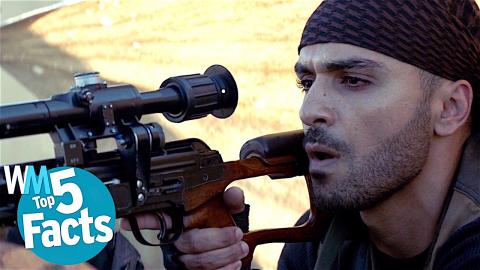Top 5 Amazing Facts about Snipers

Top 5 Deadly Facts About Snipers
Dial in your scopes and take aim! With deadly precision, these soldiers are an incredible force on the battlefield! In today's instalment of WatchMojo's Top 5 Facts, we're counting down the most interesting things that we could learn about snipers, and what makes them so deadly. We're going to be looking at the sniper's tactics, challenges, and just what they're capable of.
Special thanks to our users speechjon and Antonio Lorusso for submitting the idea on our Interactive Suggestion Tool at http://www.WatchMojo.comsuggest
Top 5 Sniper Facts
With deadly precision, these soldiers are an incredible force on the battlefield! Welcome to WatchMojo’s Top 5 Facts. In today’s instalment, we’re counting down the top 5 facts about snipers, and what makes them so deadly. We’re going to be looking at the sniper’s tactics, challenges, and just what they’re capable of. So dial in your scopes and take aim!
#5: Snipers Pretty Much Never Work Alone
One of the sniper’s primary and most important jobs is to cover and provide over watch for other units conducting operations, keeping their fellow soldiers safe. Task aside, they virtually always have a spotter. It seems logical to have at least one person watching the snipers back, while they’re focused downrange, but what many don’t realize is that the spotter is typically the more experienced sniper. It’s the spotter’s job to help find targets, then identify that target’s distance, as well as a variety of factors that could affect the path of the bullet at that range, and help make adjustments to the scope. At the end of the day, the shooter’s pretty much just a triggerman.
#4: Snipers Can Use Sound to Locate Enemy Snipers
Bullets move faster than the speed of sound, so after a gun fires, the distance between the bullet and the sound wave emanating from a gunshot grows larger and larger. This allows snipers to use a technique called “Crack-Bang”. As a supersonic bullet flies past a sniper, it creates a distinct noise called a “ballistic crack”. By then counting the seconds between the crack and the following bang created by the rifle firing, the data can be used to range the distance of the sniper. Unfortunately, the technique is only good within 450 meters. However, DARPA– a branch of the U.S. Department of Defense– has developed a device called the boomerang that basically does the same thing, just with fancy microphones and computers.
#3: The Longest Distance Recorded Kill Was Just Under 2.5 KM
If that seems like a tough distance to grasp, just think about this: Imagine standing at one end of a football field, and seeing someone at the other end. In 2009, a Corporal of Horse in the British Army was able to make two confirmed kills from a distance of 27 football fields, or just over a mile and a half. After a two-man Taliban machine-gun team targeted soldiers from the sniper’s unit, the sniper was able to hone and kill them both using a .338 Lapua Magnum rifle, in spite of the fact that the targets were about 900 meters past the recommended effective range of his rifle. It was later calculated that the bullet was in the air for about six seconds before it hit the target. Upon returning from his military tour, the sniper in question suffered severe PTSD, stating that he is haunted by the images of the people he’s killed. Out of respect for him and his privacy, we’ve decided to leave his name out of this video.
#2: Many Factors Can Throw off a Bullet’s Path
The most obvious factor is distance, since bullets don’t actually fly, but instead fall in a very specific direction. This means their path is really a big arc, and snipers need to identify their targets range in order to make sure that arc connects with the target. But the longer the range, the more factors can possibly alter a bullet’s path. Wind, humidity, air pressure, altitude of shooter versus altitude of target– all of this can alter the bullet’s trajectory and has to be accounted for when adjusting the scope. The aforementioned record-holding sniper stated that the conditions to make his shot at that range happened to be perfect on that day. He even had to adjust for something called the Coriolis effect, meaning that while the bullet was in the air for six seconds, the rotation of the earth caused his target to move. At long distance, this often requires trial and error, meaning that whole “one shot, one kill” thing is more often than not one big plop of BS.
#1: Being Able to Hide is Just as Important as Being Able to Shoot
Snipers rely on their ability to hide for protection. As they learn to shoot, snipers are also taught to think outside the box, crawling and staying where most people wouldn’t think to go. Camouflage is a sniper’s best friend. Most snipers wear an outfit called a ghillie suit, which uses drapey materials and some of the environment foliage to break up the outline of the human form, making it difficult to spot. Camo doesn't stop there either, as the worst mistake a sniper can make is to forget to camouflage their weapon! As there are no straight lines or perfect circles in nature, rifles tend to stand out. Breaking up the lines of the rifle, and hiding the black circle created by the scope, can essentially save a sniper’s life.
Did these facts get you thinking? What fascinating facts about snipers did we miss? For more precise top 10s and well-hidden top 5s, subscribe to WatchMojo.com.
